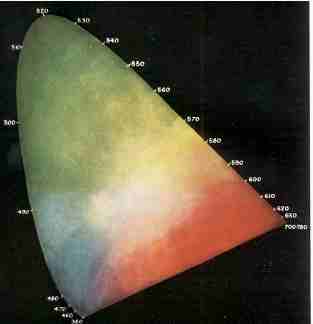The point of this page is to intimate how color reproduction systems are limited, especially color printing and color television. The color spectrum graphic was scanned from a 1955 text on color television, so it begins with about the same hue and saturation limitations as the monitor you're watching. The rest is speculation...
 the disparity between NTSC and P22 triangles in the green area. [1] The 1953 FCC adoption of NTSC COLOR TELEVISION STANDARDS defined the intensity and hue of red, green, and blue in terms of x-y coordinates on the color chart. They are labeled NTSC red, NTSC blue, and NTSC green on the chart: Red 0.674(x) 0.326(y) Green 0.218(x) 0.712(y) Blue 0.140(x) 0.080(y) [2] Manufacturers of MONITORS for the BROADCAST INDUSTRY were not governed by an industry standard (although a broadcast monitor with a 15GP22 tricolor picture tube could probably effectivly meet the 1953 FCC standard for red, green, and blue). It was not until 1979, however, that a broadcast monitor manufacturer had an industry standard -- the Society of Motion Picture and Television Engineers' SMPTE "C" standard for intensity and hue of red, green, and blue phosphors. They are labeled P22 red, P22 blue, and P22 green on the chart: SMPTE "C" broadcast monitor phosphors: Red 0.630 0.340 Green 0.310 0.595 Blue 0.155 0.070 There is a clear and significant difference between the coordinates for NTSC green and SMPTE-C P22 green. [3] Now here's the odd thing: The TELEVISION MANUFACTURERS have no standard for x-y coordinates on the color chart. The EIA (Electronics Industry Association), an organization of manufacturers of electronic-based consumer products, recognizes the SMPTE "C" phosphors, but did not use them, or any other standard including NTSC, to define colors of phosphors. Manufacturers are free to select their own intensity and hue for red, green, and blue in terms of x-y coordinates on the color chart. Here's an intersting update from Dave Corbett highlighting the colorimetery saga from an industry perspective. Click here. Update: 02 May 2002.
|


